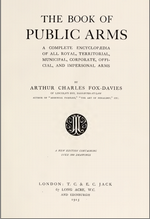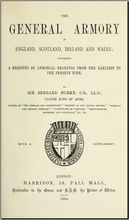Identifying Shields
So you are out and about and you find some item of heraldry, on a building or structure, or on some object - how do you find out who it belonged to? Here are a few tips and tricks to find the owners of English heraldry - you can try the same ideas in other countries but you will need other sources.
Success is not Guaranteed!

Sometimes identifying the owner of a coat of arms is fairly easy - if they are displayed on a public building you probably have a good chance of success - if they are in a private home, or on some found object without any context then your task is much, much harder. And if you don't have any information about the colours then your task may become impossible.
So, understanding that, what can we do to try and identify the armiger, or the holder of the arms?
Types of Arms
One of the first things to recognise is that arms are not just held by named individuals or families, holders can also be:
- Corporate Arms - companies, guilds and other organisations
- Civic Arms - cities, towns, counties or other geographic regions
- Ecclesiastical Heraldry - Senior members of the established church may hold arms associated with their position
- Royal Heraldry - similarly, members of current and past royal families held arms associated with their royal position

Knowing this, we can see why arms on public buildings can be relatively straight-forward to identify - the trick is finding out what the building was originally constructed for - a current or former town hall, library, fire station and so on will likely be displaying civic arms. Palaces have royal arms, major church buildings hold Ecclesiastical arms (but note that smaller churches may well include arms of the local lord or noble, or some other substantial local donor).
The first two categories above are often lumped together under the title "Public Arms" - DrawShield's online resources include The book of Public Arms, that can be a useful resource for those in the UK looking up at a major public building!
Wikipedia is particularly strong on Royal arms, of all European families, so that is good source both of information and images. I'm afraid that I don't know much about Church arms.
But what if you are in a private house, or have an object with arms on it? What then? You need to ask:
Where Am I?
First, consider your location. Does the building itself have a name that contains a clue? Are there any prominent local families? If the arms are part of a Memorial, such as a gravestone, tomb slab, or stained-glass window, then the owner's name will often be engraved nearby.
Do however check that what you are looking at is indeed a coat of arms - especially on the outside of houses subject to the vagaries of a British winter what looks like a coat of arms might be an insurance company badge, a gargoyle or just some decorative architectural flourish by the builder or stone mason.
Starting From a Name

If you believe that you have identified a possible family name, the next stage is to look it up in an armorial or roll of arms. For English heraldry I use Burke’s general armoury of 1898 and Fox’s armorial families of 1926. Both of these are available through archive.org, and Google books but I prefer to use an off-line PDF version for reasons I will come to later. Remember that a single family name may have many different coats of arms associated with it, so you may have a little reading to do. The same family names recur across the country, often totally unrelated. Sometimes the armorial will include a geographic location for the family, which may help. Also be aware that although armorials are almost always organised alphabetically they often have an "appendix" containing late additions and corrections, so check there too. Obviously what you are looking for is a blazon that matches the arms you are seeking to identify. Sometimes there is an accompanying illustration but if not you can always try typing the blazon into DrawShield to see if it is able to create a representation that you can use to compare.
Starting from a Blazon
If you do not have a name and must work just from the image of the shield itself then there is a little more work to do. The first stage is to work out the blazon, looking especially for any unusual features. We can then do a full text search for these features in an armorial, this is why I prefer the off-line PDF versions. I use the search tool in a PDF reader to display all the matches, including the context, all at the same time. Ideally we need to search for a feature that is not very common, in Burke's Armorial, "a lion rampant" occurs thousands of times, "10 martlets" occurs only a few dozen and it is feasible to check each "hit".

To construct the search term some care is needed to understand how our source document uses abbreviations, spellings and whether numbers are digits or words. Burke's armorial for example shows numbers as words and always abbreviates where possible with a period after the abbreviation (e.g. "az." for "Azure"). An important consideration for these older documents is to understand that they have been scanned using optical character recognition and that this is prone to errors, as many as one in 20 words may be incorrectly identified. This means we might not find them with a simple text search, so it is best to try several different searches before giving up. Also remember that for carved shields, gravestones etc we probably will not have any tinctures so will not be able to search for these.
If the shield really has no unique features or consists of some very simple and common heraldry a different approach is needed. Firstly as a rule of thumb the simpler shield is the older it is likely to be (and the opposite is also true). If all we have to go on is a major ordinary or single charge then I suggest consulting William Berry's 1828 "Encyclopaedia Heraldica". Volume 1 includes a cross-reference of ordinaries charges to family names, so you can for example find all those families which include "a chevron sable" in their arms. All four volumes are available from archive.org, although note the date - any Shields later than this will not be included although as we said above this should not be a problem for the older simpler Shields.
Still No Luck?
Call in the professionals! If you are stuck, or want to find out more about what you have already discovered then you may need to engage the services of a professional genealogist or historical researcher. Take a look at our Genealogy page for more advice.
Permanent Link to this page: https://drawshield.net/docs/articles/identifying-shields.html
Please Help!
DrawShield is a Free service supported by its users.

If you can, please help cover the cost of the server, or just buy the team a coffee to say thanks!
 Buy me a coffee
Buy me a coffee


